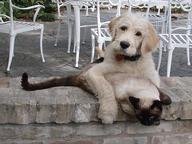Quiz Answer Key and Fun Facts
1. Before bringing your new puppy home, you need to puppy-proof inside. Which of these things should be removed or put in a safe place?
2. What is the first thing to look for when checking that your yard is puppy-proof?
3. Puppies need a *lot* of stuff! Is it better to go shopping for what your new puppy will need before bringing it home, or after?
4. True or false: It is a good idea to adopt your puppy before the age of eight weeks.
5. Should only one person choose the new puppy and meet it before deciding to make it part of the family?
6. What is the safest way to bring a new puppy home in the car?
7. When you and your new puppy get home from the shelter or breeder, what is the first thing you should do?
8. Why is it important to take your new puppy to the veterinarian as soon as possible, even if it seems healthy?
9. Training your new puppy starts as soon as you bring it home. What are the first lessons about?
10. How soon after bringing your new puppy home should you start a training class?
Source: Author
Catreona
This quiz was reviewed by FunTrivia editor
looney_tunes before going online.
Any errors found in FunTrivia content are routinely corrected through our feedback system.
